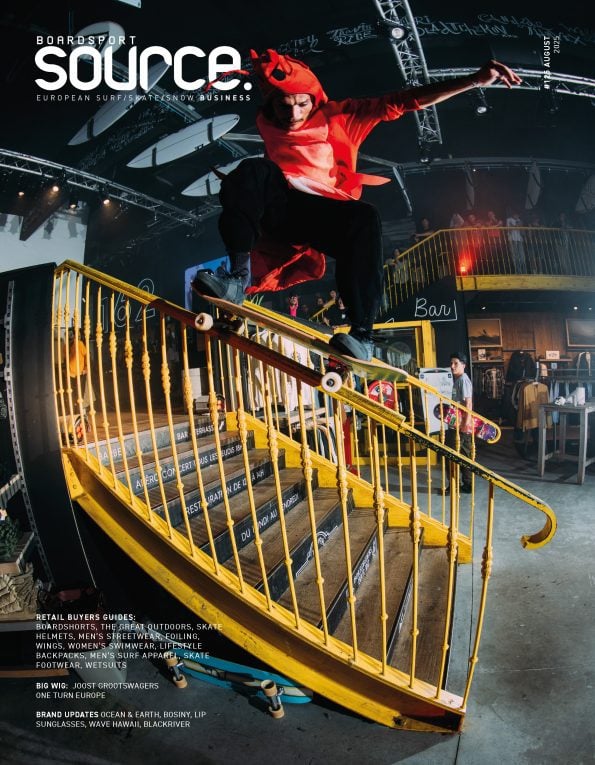
Just the Facts? Surfing and Skateboarding Premiere at the 2020 Tokyo Olympics
Will the 2020 Tokyo Olympics rob surfing and skateboarding of their core appeal? Let’s not get all bitter and negative: SOURCE writers Dave Mailman and Dirk Vogel serve up the facts – and a side order of perspective.

Illustration by SOURCE
Surfing at the 2020 Games: What we know
By Dave Mailman
No matter your opinion on the Olympics and competitive surfing, the sport will be included in the Summer Games at Tokyo 2020. And there is nothing anyone can do about it. “Surfing has entered the Olympic games, a monumental, game-changing moment for the sport. Surfing is ready to embrace the Olympics and take its inspiration, love and passion to the world’s greatest sporting stage,” said the official statement by the governing body of Olympic surfing, the International Surfing Association (ISA).
Now, one could argue that the ISA is overstepping its bounds by implying that all surfers embrace Olympic surfing. Many hardcore surfers don’t think surfing should be a professional sport, let alone be in the Olympics. But there is no denying that the ‘sportification’ of surfing is very important.
On a conference call with members of the surf media, WSL CEO Sophie Goldschmidt stated: “The 2020 Olympics is another massive opportunity, it allows us to become relevant in markets we aren’t to date. Then again, it’s the broader media offering: how do we embrace a wider audience and branch out to the lifestyle areas, as well as being very focused on our elite competitions?”
That’s exactly the question at stake here. The ISA’s qualification system requires WSL surfers who wish to compete in the Olympics to also compete in the World Surfing Games, until now rarely attended by top professional surfers. But at the same time, by embracing the Olympic movement in order to reach a greater audience, is the WSL is also diminishing the importance of its elite competitions and its world titles? What it does by doing this is legitimizing its direct competition and allowing a new international contest into the mix.
Ask yourself which is more important to sponsors and the general public: a WSL world title or an Olympic gold medal? Not sure? My point, exactly.
But all emotions aside, quite a few questions remain about what Olympic surfing will actually look like from an organizational standpoint. Will it be held in a wave park or the actual ocean? Who keeps track of qualifications and how many riders per country are allowed?
“The contest format and judging criteria are still to be determined for the Olympics. Our technical team is working on that,” said Evan Quarnstrom, Marketing and Media Manager at the International Surfing Association (ISA).
But details are starting to trickle in from the ISA, so we have compiled what we know about the ins and outs of surfing at the 2020 Games:
- The current date window for the Men’s and Women’s Surfing events at the 2020 Olympics is currently posted as July 26-29, 2020. But according to insiders, these are just placeholders; similar as in Olympic sailing for the same reason: weather. If the competition needs to account for inclement weather and low surf, the events could happen on any day during the official Games until August 9, 2020. It’s also worth noting that it is the ISA who determines the call each day, and not and not the IOC, allowing seasoned vets to run the comp in the best conditions possible. For example, the ISA will be able to run a few heats in the morning when the wind is offshore and then go on hold until the next day, just like on the Championship Tour.
- The surfing event will feature an equal number of riders from both genders: 20 men, 20 women.
- In order to qualify, individual surfers earn spots via a hierarchical list of qualification events (see below). In other words: qualifications are determined per rider, not by countries. Generally, there is an allotment of two riders per country in each gender (so maximum two men and women per country).
- All national team members must participate in 2019 and 2020 ISA World Surfing Games to be eligible for Olympic qualification.
The hierarchical order of qualification is the following:
- 2019 World Surf League Championship Tour: First ten eligible men and first eight eligible women.
- 2020 ISA World Surfing Games: First four eligible men and first six eligible women.
- 2019 ISA World Surfing Games: Top finishing eligible surfer of each gender from Africa, Asia, Europe and Oceania.
- 2019 Pan American Games: First eligible male and female surfers.
- Host nation slot: One male and one female slot for Japan, unless already filled via another qualification scenario. If so, the slot is reallocated to highest-ranked eligible surfer from the 2020 World Surfing Games.
- As for competition terrain, there have been some rumours, as some interested parties in surfing are lobbying for artificial wave terrain. But in spite of confirmed Kelly Slater Wave Co. and Wavegarden projects underway in Japan, the ISA insists the surfing event will be held in the ocean. To be precise, at Tsurigasaki Beach in Chiba, 100km from Tokyo centre.
- Speaking on the issue, ISA President Fernando Aguerre said: “The ISA is excited about showcasing surf culture and lifestyle through an innovative beach festival concept at the Games.” The organizers also wish to use the event to promote the beauty of the Japanese coastline and the quality of local waves for surfing.
So there you have the facts. As for feelings within the surfing community about the sport’s inclusion in Tokyo 2020, everyone who surfs has their own…
Skateboarding at the 2020 Games: What we know
By SOURCE Skateboarding Editor Dirk Vogel
In 1965, The Quarterly Skateboarder magazine already predicted “a real future for the sport – a future that could go as far as the Olympics.” But only under the condition that “skateboarding does not become a sport of rebels and radicals.” Well, now it’s officially happening: Skateboarding will debut at the 2020 Tokyo Olympics. And guess what, the rebels and radical are in full rebellion!
Core companies and practitioners rally behind the argument: “The Olympics need skateboarding more than skateboarding needs the Olympics.” They have a point, as kids these days can hardly be bothered to watch Olympic mainstays such as Fencing or Equestrian Dressage on TV.
But looking at current participation numbers, skateboarding could also use an Olympics “boost”: Whereas almost 9 million participated in skateboarding in the U.S. in 2007, the number is now at 6.4 million according to the 2017 SFIA Topline Participation Report. Out of these participants, 4 million are casual and 2.5 million core (down from 4 million in 2007).
Core participants are exactly what our industry needs, as they are the ones who shred boards, tear up shoes and buy skate equipment on the reg. Right now the only demographic posting growth are the 24 to-34-year-olds, which now outnumber teenagers for the first time (SFIA).
Whether or not professional athletes competing for gold medals in national team jerseys will bring in new blood remains to be seen. Meanwhile, here’s the official lowdown of what we know about skateboarding at the 2020 Tokyo Olympics:
- There will be two skateboarding events at the 2020 Olympics: Skateboard Street (July 24–25, 2020) and Skateboard Park (August 4–5, 2020). Each will feature the top 20 qualifying participants from around the world. These riders are determined in qualifier events recognized by the official governing body for skateboarding, World Skate. There are also quotas in place, for instance a limit of three riders per country.
- World Skate is the IOC-recognized, international federation governing skateboarding. It was established in 2017 in a merger between the ISF and FIRS. World Skate recognizes 124 national associations around the world, for instance Germany’s DRIV. These national associations receive financial and organizational support, for instance by the German Olympic Sports Association (DOSB), to establish teams, hire coaches and conduct camps for training.
- An equal number of men and women will compete in Olympic skateboarding – so 40 men and 40 women total – in line with the Olympic Charter to “encourage and support the promotion of women in sport at all levels”. National associations have established women’s teams while brands such as Vans promote women’s skateboarding. A wise move: Only 27.5% participants in the U.S. are female, and their share has stagnated for the past two years (SFIA).
- Both disciplines will have their own qualifying series and judging formats. In Street, the IOC recognizes the Street League Skateboarding (SLS) World Tour as the official qualifiers. Next year, SLS will expand its tour to five events – all featuring women’s competitions – and double the number of competitors through an expanded qualifying format. Although yet to be confirmed, the Vans Park Series (VPS), now the official world championship format for Park Skateboarding, looks like the shoe-in candidate for Park.
- Athletes in qualifying series are already being screened for “performance-enhancing substances” by bodies such as the USADA in the US, the same organization that tests UFC fighters.
- While marijuana is legal in countries like Canada and the Netherlands, as well as several states in the US including California, the Olympics will not allow its use. One of the world’s best park skaters already flunked a doping test for THC – the shape of things to come and a red flag for Olympic opponents.
- Competition terrain will be constructed by sanctioned park builders, including the official designer and builder of Street League Skateboarding, California Skateparks.
- Olympic participants will not wear their sponsor’s apparel but some kind of national uniform. But sponsors’ shoes and decks are okay, if they are commercially available.
- Skateboarding in the Olympics will receive broad media coverage from national TV networks as well as private broadcasters such as Sky, ESPN, and ABC. Vans also teamed up with skateboard-specific web streaming service ETN to broadcast its Park Series this year as an official partner.
Speaking of partnerships, the Olympics are still a stretch away and skateboard marketing budgets have seen better days. Did you notice that the SLS World Tour this year is no longer presented by previous headline sponsor, Nike SB? Are brands holding out until 2020 and hoping for a boost in exposure once the “Big O” rolls around? Perhaps. Maybe. We’ll keep you updated on what we know.




